When we’re making strategic decisions, one thing we always look for is more data. Whether a client is looking to launch a product into a new market, understand what channels to promote their offering on, or learn more about how to position themselves against their competitors, all of these decisions can be better made with better data.
If you’ve followed our blog or spoken to someone at Coast Digital before, you’ll know we’re always looking at the numbers. From Google Analytics to biometrics, we look for ways to get the answers we need to help clients succeed – or sometimes to help us get our clients asking the right questions. There’s another source of data we have access to, thanks to the right tools and technology, that I’d like to shine a spotlight on.
Social listening is broadly understood as a way to identify brand mentions, share of voice, sentiment towards a given brand or topic, etc. While all of that is true, the sheer volume and depth of information that exists in the social landscape means there is scope to get some really fascinating insights beyond this.
I’m a big believer in ‘show, don’t tell’, so that’s what I’m going to do. I’m going to take a topic that’s close to our hearts here at the agency and show you what we can learn through social listening. I’m going to dive into SEO, but remember this could be any topic or brand. I’m going to demonstrate the possibilities – I’ll leave it to you to think about the kind of questions this could help you answer around your brand, your audience, and your industry.
The significance of search terms
If we’re going to capture the conversation around SEO, we need to think about how people talk about search. This then helps us build a set of keywords we can use to identify relevant social posts to analyse – in a way, a mirror for what we would do when first building an organic search strategy.
We start with the obvious, SEO and search engine optimisation. We want to capture a broad segment of data that includes regional variation too, so we want to include search engine optimization as well. We also know people talk about organic search and organic traffic, so we’ll pull those in as well.
When we run this though, we start to see some data that looks like a little odd. One thing we can look at is the brands, products or figures that are being pulled through into the data set, and assess what kinds of trends are making are regular appearances or are flagging up as hyper relevant to our dataset. Interestingly, what we see is a large number of Korean pop culture topics and celebrities.
Now, it’s not impossible that people that talk about SEO are also big K-drama fans, but it certainly warrants some investigation. What we find is that ‘Seo’ is Korean name and, most notably, the name of some prominent figures in Korean pop culture, including one that has been involved in some controversy over the last 12 months – the kind of thing that gets you talked about on social media.
For reference, I’ve pulled the Wiki snippet from a few searches around these celebrities. While interesting, they’re not relevant to the research we’re doing here.
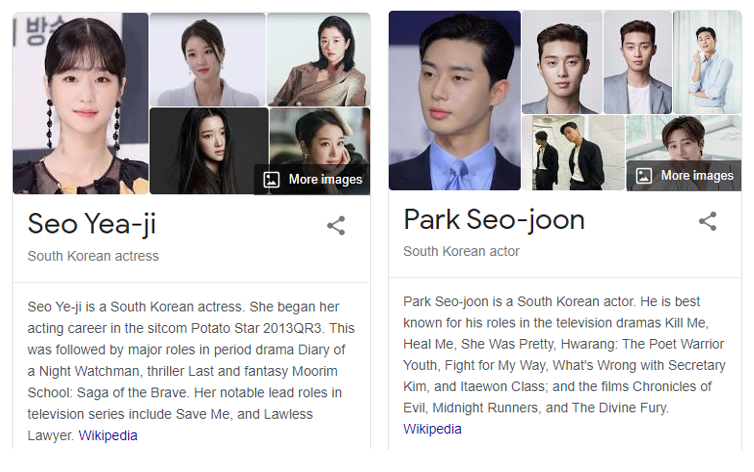
We want to get rid of this data. This is a challenge because it’s a broad topic – but we can refine our original query to get something more specific to what we want to investigate. To do that, we can add another level to our query – to only report posts that also mention another relevant term. For example, webpage, reporting, analytics, etc.
Running this amended segment through our tools, for 2021 so far (up until the 30th of September at the time of writing), we end up with a sample of 363k posts – an average of 9k per week. More than enough to do some interesting research!
The reason I’m running through this before presenting any findings is, firstly, because I think it’s always good to show your working. But secondly, it illustrates what we can do in this arena. There’s 3 key points from this initial example.
- We can pull data retroactively – we’re pulling 9 months of data, whereas social listening can often be seen as a ‘what’s happening right now’ style of reporting.
- We can identify key trends and brands that are featuring in our dataset – for better or worse, we can see who or what is present in what we’re analysing, which in turn means…
- We can be flexible with how we pull the data – since we can see and assess what we’re pulling through, we can make sure we remove irrelevant data. This works the other way too, meaning we can ensure we capture things that might be missing on a first pass.
Now, let’s see what we can find.
Posts with the most
A good place to start is with what’s being shared. Users reading or liking a social post are both good engagements, a share (or re-tweet or whatever else it might be called on a given platform) is a step above – it’s an affirmative action whereby a user finds content so valuable they want to be seen to share it with their own network.
When we look at the most shared SEO content on social in 2021, we see a few broad trends.
- Learning and development
- SEO in demand
- Personal stories
Learning and development
This one maybe shouldn’t come as a surprise – SEO and the associated community has always been high on learning and knowledge. The three most shared posts around this topic, all on Twitter, are below.
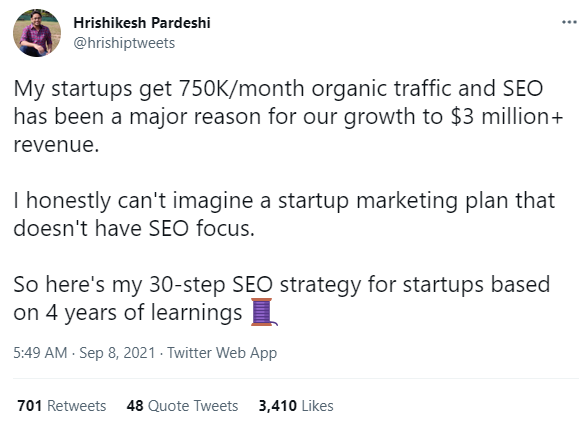
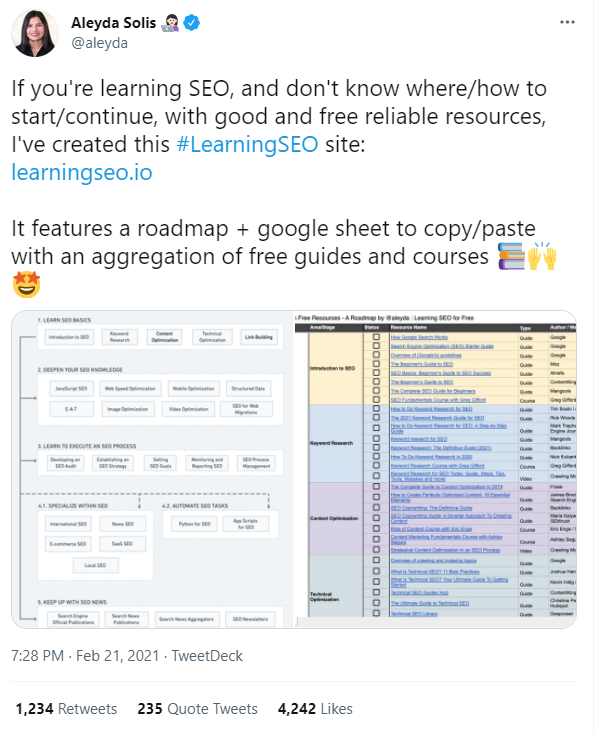

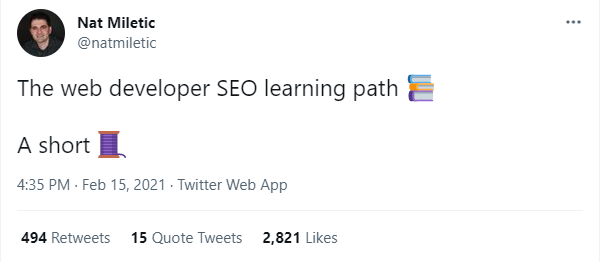
What can we learn from this?
Length is no barrier to engagement. Two out of these three posts are threads. The post from @hrishiptweets is actually a 29-Tweet thread. The post from @natmeiletic is only a 7-tweet thread, but still fairly ‘long form’ by Twitter standards.
The SEO community have shared these posts over many other shorter, snappier options. This tells us that even in the ‘micro-blogging’ environment of Twitter, the SEO community is hungry for long-form content.
To be good at SEO, you need knowledge and understanding of the field – so the priority is to get that information, rather than to find a pithy or snappy tweet that sums it up in less characters.
Quality resources are held in high regard.
As stated above, we know there’s an appetite for long form content. We can see from the most shared post that a high-quality learning resource is a draw for SEOs.
It’s also worth noting this content is described as ‘good’, ‘reliable’ and ‘free’.
What all of this tells me is that SEO remains fertile ground for content marketing. Clearly there is a desire for long form, high quality information – knowledge transfer is driving quality organic engagements in the SEO social landscape, so if I were promoting SEO services that’s what I’d lean into.
SEO in demand
There’s been a long running trend of people talking about how “SEO is dead” – though more often than not it’s something people are responding to, e.g., explaining why that isn’t the case, rather than suggesting this statement is true. If you Google “SEO is dead”, here’s a sample of what you’ll see:



Running the phrase “SEO is dead” through our social listening tools, we can only find 508 posts in 2021 so far that feature the phrase.
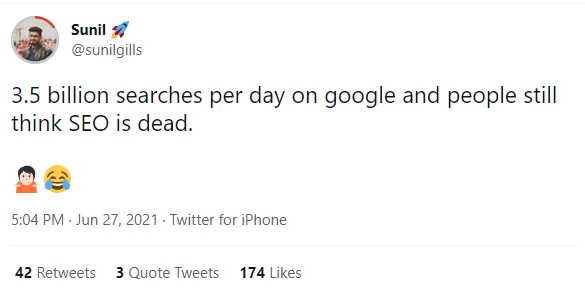
While it seems that “SEO is dead” is a self-defeating phrase, with the only people repeating it being those determined to disprove it, it can sometimes feel that in a world of paid search, programmatic display, and social remarketing, that organic search can fall by the wayside.
As a result, we see content doing well on social that is focused on demonstrating the value of SEO – more as a skill than as a service.
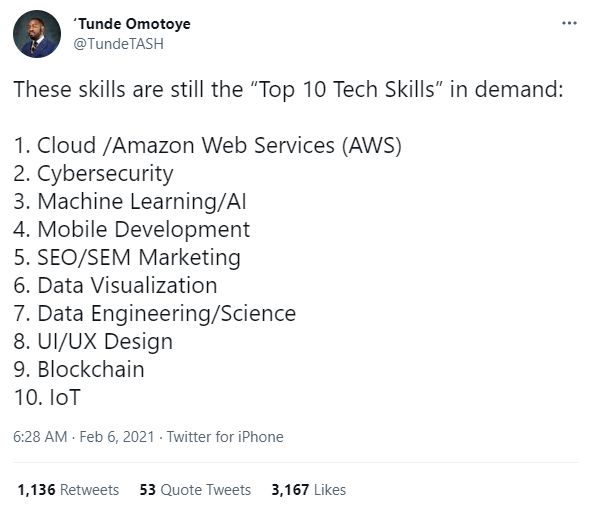

What this tells us about the social landscape around organic search is that SEOs want to promote the value of their expertise – that they want to make it clear that SEO is alive and well, and still a vital part of the digital marketing mix.
And they’re right to think that, but when we’re promoting SEO or writing content about it, we need to take a positive angle that focuses on the value of organic search to businesses and clients, rather than fighting against the perception of SEO as a dying art. Ironically, it seems the only people perpetuating that idea are those that are trying to defend against it.
Personal stories
The crux of social media is the people behind the content, whether that’s proving why their messages should be taken seriously or telling a more relatable human story. After the last 18 months, it should come as no surprise that there are there are stories that have made a mark even in the SEO community.
The single most shared post I found around SEO in 2021 was the following:
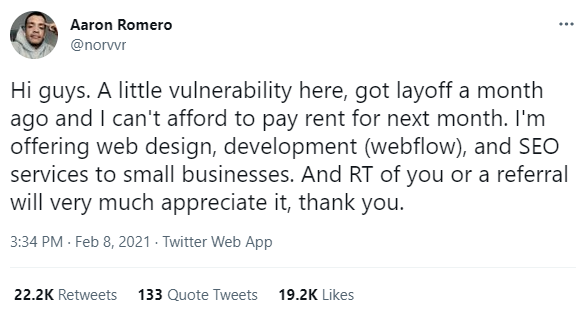
22.2k re-tweets is on a different order of magnitude to any of the other posts we’ve looked at. Stranger still, it’s for an account with hardly any presence of its own.
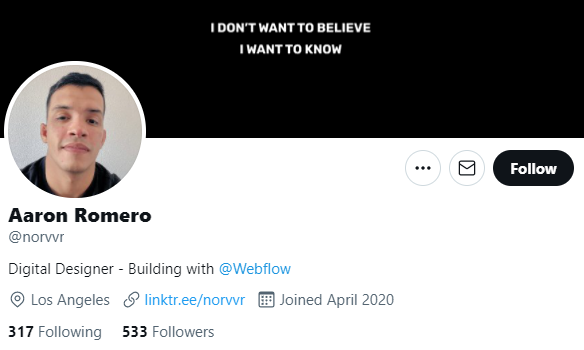
What this tells us is that the SEO community is passionate and willing to help. It also shows us the power of relatable stories, and that social media can still do what we maybe thought it would do more of when it first emerged – push out a human story with a positive outcome.
Big players
We’ve looked at the individual posts that have driven the most shares, but as mentioned before, there are another 363 thousand or so posts that make up the landscape. The 3 biggest players that have engaged with SEO on social in 2021 are:
The Economist – 25 million followers
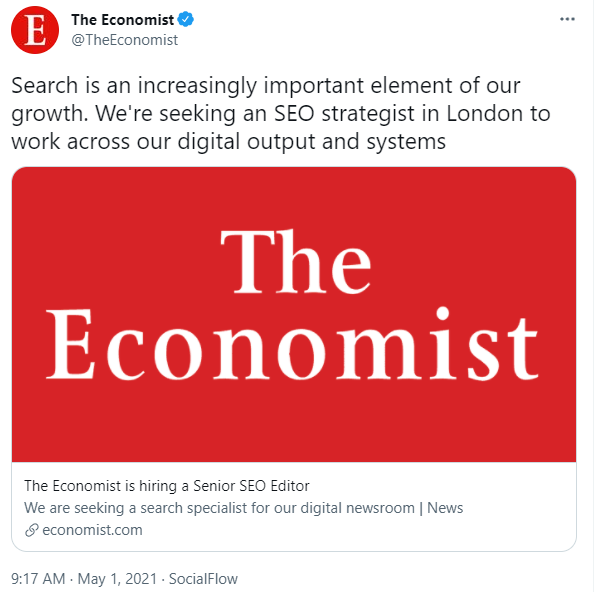
Funny or Die – 13 million followers
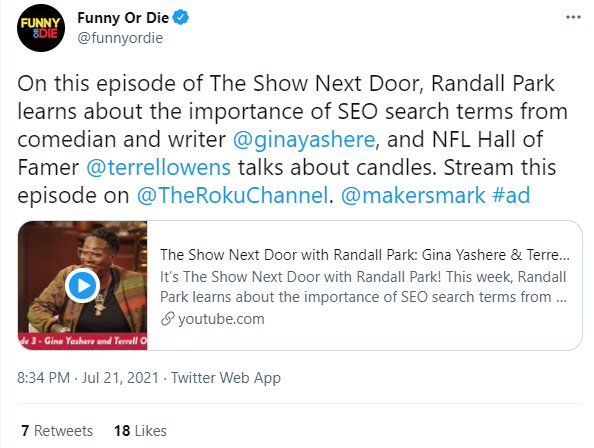
Hootsuite – 7 million followers
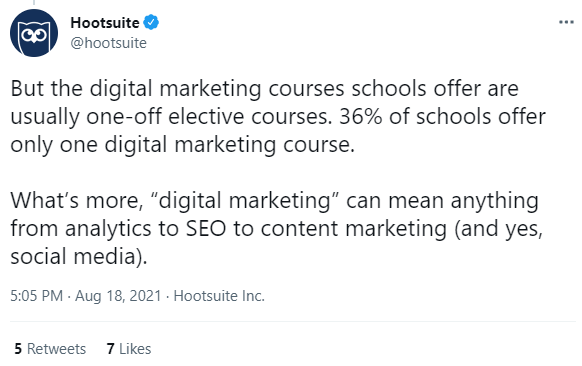
While these are huge social media accounts in terms of their following, they’re not particularly relevant to the world of SEO, though Hootsuite is a good match for broader digital marketing.
When I think about SEO, there are certain names that come to mind – so if we keep going down that list of big accounts that have engaged with SEO, do we find the names we’d expect, like Moz, Search Engine Land and Search Engine Journal?
The next highest ‘marketing adjacent’ account in the list is Clients from Hell, which is not the best look when we’re thinking about SEO as a service to be sold!
Continuing on, we see the SEMRush blog, @Moz on Twitter and @googleanalytics on Twitter. So some of the names we might expect do feature, though as mentioned before they are blown out of the water by bigger publications wading into the conversation.
There are some up and coming accounts in the mix too – most notably @GainRankSEO on Twitter who’d been showing some strong social growth in the first half of 2021. Unfortunately, the account now seems to be dormant and as such engagement has dropped off.
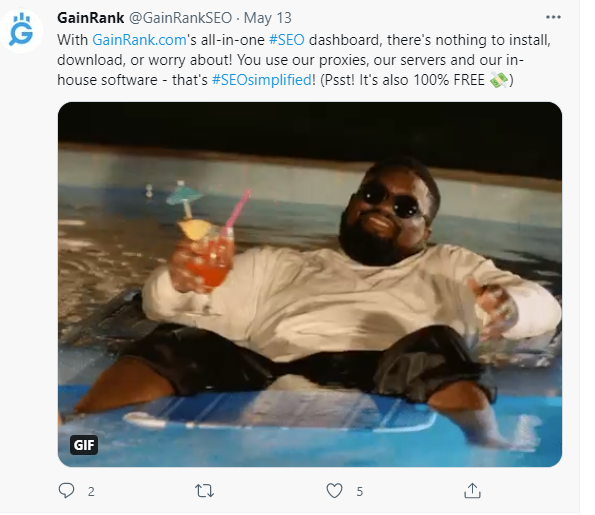
Looking at the big players on social gives us insights into the challenges we’ll face if we’re trying to make an impact. This is particularly powerful when looking at trying to break into a new service area or make ground with a new audience – understanding who is already present in the space not only tells you what you’re up against, but also gives you an early idea of what’s working in that arena.
Scratching the surface
There are so many more dimensions we can slice this data up by, but this article is pushing 2,000 words already so I’ll wrap up with some quickfire insights to give you an idea of the scope of what we can find out.
- We can look at what the people who have talked about SEO are interested in – people that have engaged with SEO on social are 60% less likely to be interested in sports than the general population.
- We can look at demographics – our SEO audiences are 65% male against 35% female, and are most likely to be 25-34. They’re also 7.7% more likely to have completed higher education than the general population.
- We can look at languages and geography – after English, Spanish is the second most common language to discuss SEO in. While the US is, as you’d expect, the biggest source of noise around SEO, India, The UAE and Australia also feature strongly.
The list of possibilities keeps going. As is always the way, once we have the data and the technology to analyse it, it’s just a case of understanding how to apply it to get what we need.
As I mentioned at the start of this article, the data and the insights I’ve shown here could be applied to your business, your sector, or even your competitors.
If you’d like to talk to an expert about how you can get access to this data and how it can help you make better business decisions, then get in touch – we’d love to help. Alternatively, you can check out our Social Listening service page to find out more about what we can do.
